Sure, road trips are not for everyone. If you’re into interminable airport security lines, road trips are not for you. If you enjoy being treated like cattle, go ahead and board that stuffy airplane.
But if you appreciate brassy threads of sunlight the color of French horns streaming across an Idaho highway, a Western road trip might be just for you. Read more »
We have eight ideas for road trips: In California: Gold Country, Mineral King Road, Eastern Sierra and Montaña de Oro. West adventures: Denver, Montana ghost towns, three trips in one: Nevada, Utah and Arizona and to the north: British Columbia.
You’ll also find:
- Our travel writer Christopher Reynolds takes a road trip to the northern Oregon coast.
- Short on time? Go on a weekend escape. We have 13 ideas of where to go.
- Road trip tips on gas, altitude sickness, trivia and traveling with a dog.
- State tourism offices, rental car lists and national parks of the west.
Follow our Pinterest boards: West Coast Getaways | Travel Tips
Have an incredible road trip story or a useful tip? Share your memories and suggestions with us in the comments or by tweeting at us with the hashtag #LATRoadTrips.
Drive the northern Oregon coast: Haystack rocks, giant dunes and fresh seafood

Travel writer Christopher Reynolds takes a scenic spin on the Oregon coast: four days, three nights, one tank of gas, one big sand dune, one killer coastal hike, one cheese factory, one organic farm B&B, and one bonfire in the shadow of Haystack Roc
One round-trip ticket to Portland. One rental car, pointed west. And one tank of gas.
Start with these elements, then stretch them across four days and three nights in the shape of a 270-mile triangle.
The result? A road trip to the northern Oregon coast, as far south as Pacific City, as far north as Cannon Beach.
You’ll be sidestepping Portland proper and Astoria — and every other city with a population of more than 10,000 — so you can take a little time in towns such as Tillamook, Manzanita, Nehalem and Netarts — and in the landscape between them.
Foodies are hungry for San Diego’s Little Italy, a hub for top chefs
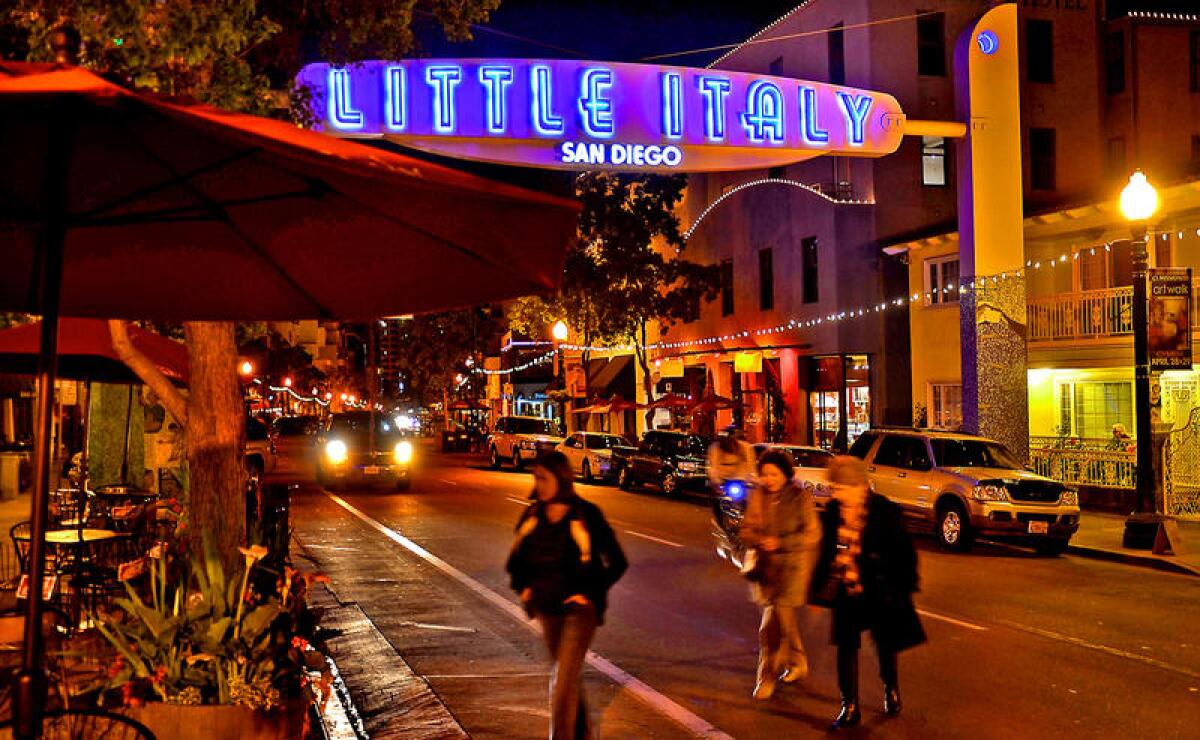
San Diego’s Little Italy has become a hot foodie destination, with big-name chefs opening restaurants. But not to worry: The neighborhood has remained true to its heritage, with Italian-themed restaurants and festivals, and you’ll still find plenty of fine Italian fare from old-fashioned to new wave.
Avila Beach’s gentle charm makes for a relaxing Central Coast getaway
Take the long, sandy shoreline of Huntington Beach. Mix in the gentle waves of Santa Monica. Add a dash of architecture from Key West, Fla. Then stir in Central Coast wines. What you get is Avila Beach, a quaint but bustling beach town sandwiched between Pismo Beach and San Luis Obispo.
Hoover Dam, an engineering marvel, is surrounded by natural wonders
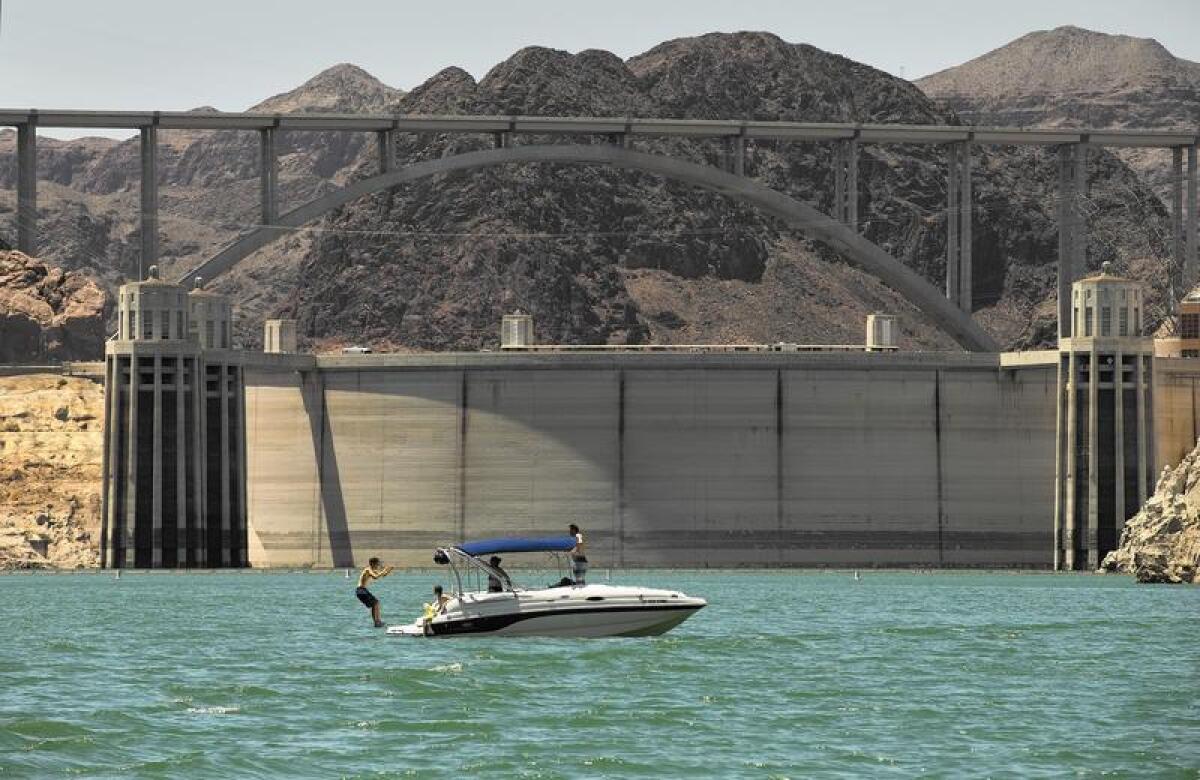
Without the massive wall of concrete called Hoover Dam, Boulder City, Nev., wouldn’t exist.
The town sprouted during the Great Depression to house thousands of workers, mainly men, who had headed west to help build the dam. People often bypass it on the drive from Las Vegas to visit the engineering marvel, but Boulder City offers a wealth of pursuits on land and on Lake Mead, the vast body of water created by the dam.
In Flagstaff, Ariz., it’s easy to get immersed in the town’s rowdy — and scientific — past
Why Flagstaff, Ariz.? Start with the Lowell Observatory, where Pluto was first spotted in 1930 (and don’t forget to peek through the refurbished Clark refracting telescope, used in the 1960s to create maps of the moon). Consider the Pioneer Museum, which celebrates this “livestock, lumber and railroad” town dating to the 1880s.
And don’t forget that Flagstaff, a mountain town that sits at 6,909 feet -- is also about its great outdoors: walking, running, hiking and biking.
Get your kicks on Route 66: Feed burros, cheer gunfighters, see Gable’s room
As pistol-packing cowboys take to Main Street (really, the only street) in Oatman, Ariz., for a mock gunfight, they ask spectators to step off the wooden sidewalks to help block traffic.
In years past, that request would have been absurd, because Route 66, with its steady stream of cars and trucks, ran through town. But with the highway traffic long gone and the surrounding gold mines closed, it’s now safe to wander at will.
Chill out at Big Bear Lake
Those of us whose air-conditioning goes on strike every summer are always looking for a place to chill (in my case, with my dog).
Big Bear Lake, a (usually) snow-fed reservoir surrounded by the San Bernardino National Forest, offers trails to hike, a dog-friendly boat tour and, if you’re lucky, temperatures so cool you may be forced to wear a jacket at night.
Boats, sea breezes, sun basking and food, food, food in San Diego
Shelter Island in San Diego is not an island -- it’s connected to the mainland by a strip of land. But that’s a good thing. You can drive right onto the tiny area to enjoy its marinas, hotels, restaurants and bayside park.
Discover San Luis Obispo’s relaxed, bohemian sensibility on a weekend getaway
San Luis Obispo is a charming college community on the Central Coast where visitors are encouraged to slow down and enjoy all that the city has to offer: good food, good vibes, sunshine and a healthy lifestyle.
Here’s your new favorite fishing spot in California: Lee Vining
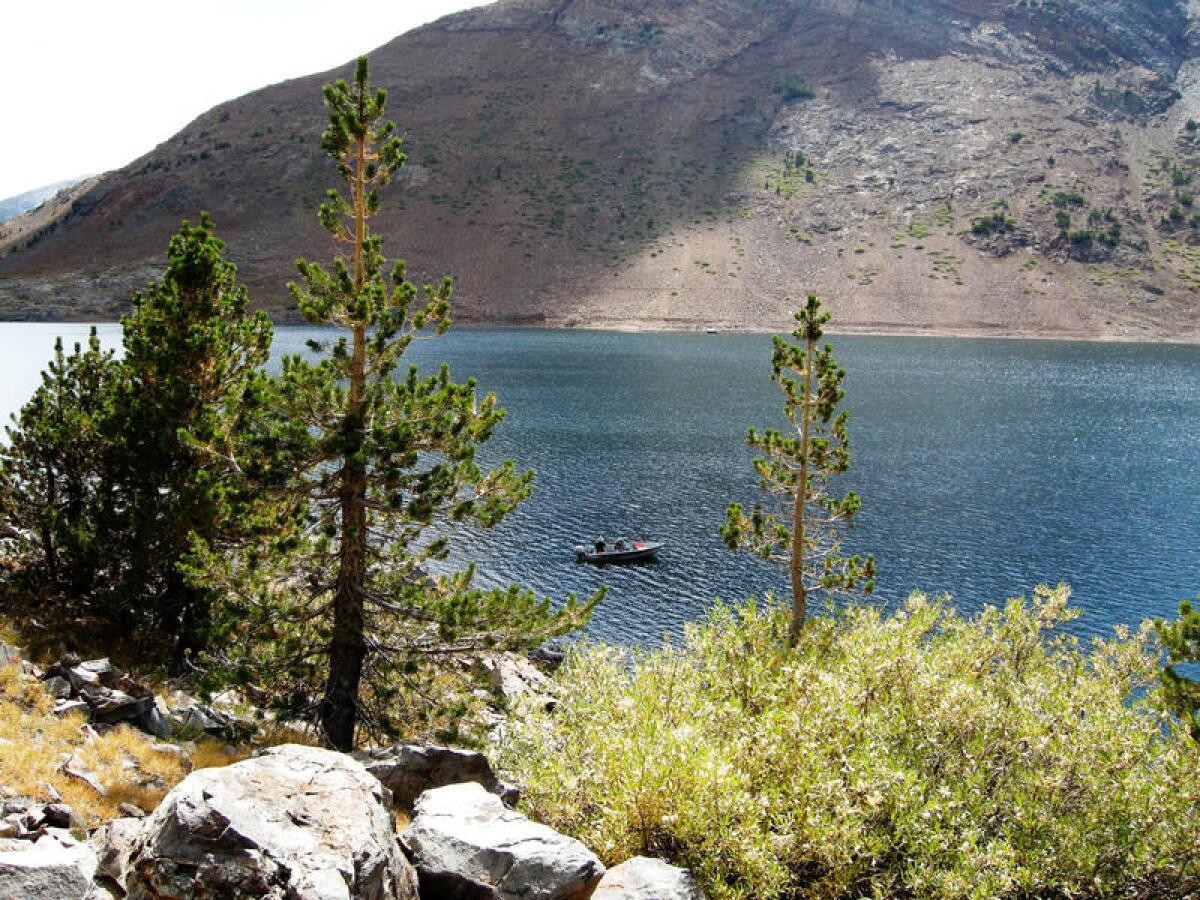
If you’ve driven U.S. 395 to Yosemite or Reno, Nev., you’ve zipped past Lee Vining, Calif., a hamlet of about 200 on the shores of Mono Lake.
Like most outdoor enthusiasts who love the Eastern Sierra, I have thought of Lee Vining largely as a spot to fill my gas tank or stock up on bait. But while researching new fishing spots in Mono County (“in season” fishing ends Nov. 15), I discovered that Lee Vining is a prime launching point for a weekend of angling.
Rustic Ojai transports the eyes and the taste buds to a spiritual plane
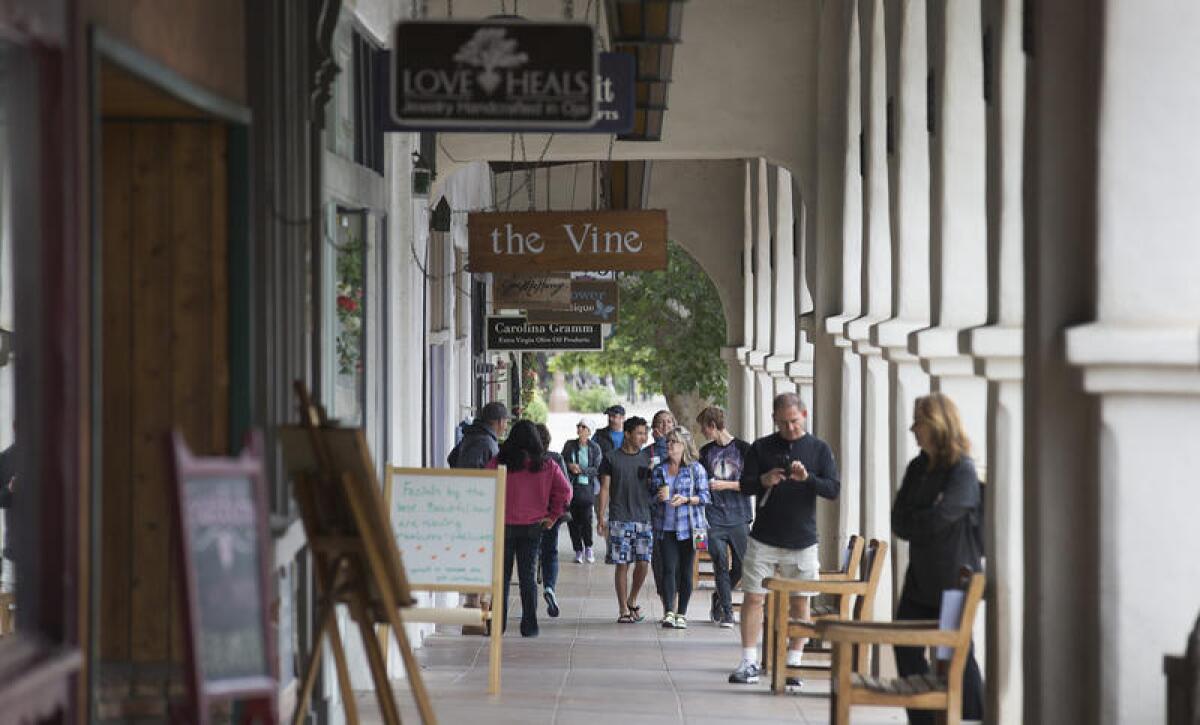
Ojai is a weekender’s paradise, a place to browse stylish shops, meet the artists and artisans who create one-of-a-kind pieces, taste the produce of organic farms, and soothe the soul in the spas and meditation centers the town is known for.
Cowpoke by day, aristocrat by night at Alisal Guest Ranch in Solvang
Alisal Guest Ranch and Resort in the Santa Ynez Valley is deliberately old-fashioned — no TVs or phones in the rooms — and promotes its outdoorsy activities in an elegantly rustic setting.
Downtown Las Vegas is now a place to stay, shop and play after a glitzy makeover
Trying to do the time warp in downtown Las Vegas is increasingly challenging. Many of the old, familiar and, yes, decaying landmarks are gone or barely recognizable after expensive face-lifts.
My favorite road trip memory – what’s yours?
When I was about 7 years old, I hopped into my uncle’s Volkswagen van along with three of my cousins, one more uncle and my grandmother. We were headed to Disneyland from Mexico City and the trip took about three days. I remember stopping in Monterrey to visit family along the way, and also in Ensenada. I also remember how my grandmother packed pounds of flour tortillas, Oaxaca cheese and avocados so we could eat on the road.
All these years later, I still think about our road trip tacos fondly – even if I was sick of them by the time we got to Monterrey! Of course, it’s the time I spent with my cousins in the back of the van and finally arriving at Disneyland that make this my all-time favorite road trip.
How about you? Do you have an incredible road trip story or any useful tips, besides cheese and avocados? Share your memories and suggestions by tweeting at us with the hashtag #LATRoadTrips or leaving a comment below. We’d love to see your photos too!
- Denise Florez
Finding Ventura County’s fine food and shopping
One doesn’t often think of Ventura County as a proto-foodie haven, but that was before I learned about Adolfo Camarillo, an early 20th century visionary, landowner and philanthropist (and the town’s namesake). Camarillo introduced new crops to the area, forever altering the local economy.
Montana’s ghost towns a mother lode for nuggets of Western history
Montana ghost towns
The route: Start at Butte, heading southeast on Interstate 90, then head to Virginia and Nevada cities by way of Norris on U.S. and Montana 287. At Twin Bridges, take Montana 41 to Dillon, then take Montana 278 to Bannack and then to Wisdom, where you take Montana 43 back to Butte .
Miles: 210, round trip
Best times: Mid-May to mid-September. You may want to avoid forest-fire season in August.
Why: The story of the West is partly the story of precious metals — gold, silver and copper – and their booms and busts, and you can follow the history of Montana by ghost-town hopping. (Kids, by the way, like hearing about the hardships endured by their counterparts in the 1800s. “You would have been down a mine 150 years ago!” is a great way to get them to hurry up for school.)
Wandering through Bannack Ghost Town’s 60 structures is like being an extra in an old western. (Bannack was the state’s first capital before gold was discovered; then Virginia City became the capital.) .
Highlights: Tours of Butte’s historic uptown and the must-see Berkeley Pit. Panning for gold and watching for ghosts in Virginia City. Bannack Days (the third weekend in July), which includes activities as diverse as hat making and quilting, shoot-outs and wagon rides. Intimate Norris Hot Springs has live music and cold craft beer.
Memorable stay: A Victorian Suite in the Nevada City Hotel and Cabins. In Butte, the historic Hodgens Ryan Mansion carries on the Victorian theme. Or you can choose Butte’s Hotel Finlen, where both Richard Nixon and John F. Kennedy stayed before they were president.
Memorable meal: The Fiesta Mexicana food truck in Dillon where Austin, Texas-style food meets small-town Montana. The buttermilk pie at the Crossing Bar & Grill at Fetty’s in Wisdom is well worth a stop.
Tourist trap: Elkhorn Hot Spring. Don’t bother.
Plan to spend: 12 hours for Virginia and Nevada cities and Bannack. But if you want to soak in a hot spring, explore the thrift stores of Butte and catch a show in Virginia City, then two days is best.
— Joanna Pocock
Seeking gold in the footsteps of nugget-hunting California pioneers
The route: 405 Freeway to the 5 Freeway to California 99 to California 41 to the California 49.
Miles: About 550 one way
Best time: Accessible year-round. Fall color makes that season particularly beautiful.
Why: More than 300,000 pioneers headed west in 1848 when gold was discovered in California. Today the historic towns that sprang up in the wake of that tide of miners, saloon keepers, prostitutes and desperadoes have sparked a new era of travel. Twenty-first century tourists visit wineries and brew pubs to taste the local favorites, pan for gold and spend time admiring the Old West architecture and inviting shops along California 49, the Gold Rush Trail.
Highlights: I drove the route in May, stopping in scenic Angels Camp, for the Calaveras County Fair & Jumping Frog Jubilee, inspired by the 1867 Mark Twain story “The Celebrated Jumping Frog of Calaveras County.” Kermit would be proud of this down-home event, which combines small-town charm with tongue-in-cheek fun. But the twisting two-lane Gold Rush Trail also offers wildflowers, meadows, lakes and plenty of historic sights and interesting towns. Among them: charming Placerville, picturesque Sutter Creek, arty Nevada City and well preservedColumbia. Don’t forget the Marshall Gold Discovery State Historic Park at Sutter’s Mill, near Coloma.
Memorable stay: If you’re looking for an unforgettable stay, try the 1959 Historic National Hotel in Jamestown, where you might get a chance to meet the resident ghost, Flo, a.k.a. the Woman In White.
Memorable meal: Order the hardy chicken pot pie at the Hotel Sutter Restaurant in Sutter’s Creek, a local favorite. The newly refurbished hotel is also a good bet for a place to stay.
Tourist trap: Skip Moaning Cavern unless you just hit the lottery. A simple walking tour costs $17.50, but if your family members want to rappel ($72 each), take an adventure caving trip ($130 each) or zip-line ($45 each), your budget could take a beating.
Plan to spend: At least a couple of days on the trail. Or more.
—Rosemary McClure
Next stop: The mystical western coast of Canada’s Vancouver Island
Victoria to Port Renfrew, Canada
The route: A circular route in British Columbia from Victoria to Port Renfrew. Take Highway 14 from Victoria to Port Renfrew. From there, follow the signs to Lake Cowichan on the Pacific Marine Road. Once you arrive at Lake Cowichan, follow Highway 18 to the Trans-Canada 1 back to Victoria.
Miles: 180, round trip.
Best time: Summer for beaches, fishing and hiking; winter for spectacular storm-watching and surfing.
Why: A rare opportunity to drive a circle route, completed in 2009, on southern Vancouver Island’s western coast. Travel through mystical, moss-draped and supersized temperate rainforest with some of tallest and oldest trees in the country. The circuit is not well known yet so the dramatic surf-or-stroll beaches of Juan de Fuca Provincial Park, which also features a 30-mile coastal wilderness hiking trail, and the villages on the way are still uncrowded and genuinely funky. An opportunity to view winter’s dramatic Pacific storms and pounding waves, best watched from in front of a fireplace in a renovated retro ’50s cabin at Point-no-Point Resort, is a (relatively) easy drive from Victoria.
Highlights: Near Victoria in Sooke, the potholes of Sooke Potholes Provincial Park are idyllic swimming holes at the base of waterfalls. Nearby, iconic Sooke Harbour House is a luxury B&B and restaurant where the concept of hyper-local West Coast cuisine was launched in 1979 by Sinclair Philip, Canada’s Alice Waters. Avatar Grove, on a dirt road outside Port Renfrew, is a pocket of old-growth rainforest with monster cedars and Douglas fir discovered in 2010. They include “Canada’s Gnarliest Tree,” a 12-foot-circumference red cedar deformed with burls. Need help finding them? Check out Big Tree Tours. Along the route, sample the Kickass Currant Mead at Tugwell Creek Honey Farm & Meadery. Drop in for lunch at the aptly named Shirley Delicious, a casual gourmet A-frame diner, or pick up smoked salmon, Dungeness crab and fresh oysters at roadside shacks and make a picnic on Sombrio Beach.
Memorable stay: Wild Renfrew Seaside Cottages, rustic luxury at Port Renfrew.
Memorable meal: Try Soule Creek Lodge overlooking Port Renfrew. The wild salmon glazed with maple syrup and citrus served in a First Nations-decorated dining room with a view is worth the drive.
Tourist trap: Stroll over the 144-foot high Kinsol Trestle bridge near Shawnigan Lake and check out the town ofDuncan’s 80 totem poles and legendary weekend farmer’s market.
Plan to spend: One day if you keep moving; two days if you want to be as mellow as the locals and the landscape.
-- Margo Pfeiff
Road trip into Eastern Sierra offers a grab bag of simple pleasures
U.S. 395 and the Eastern Sierra
The route: Los Angeles to June Lake, Calif., by way of the 5 Freeway to California 14 to U.S. 395.
Miles: 320 one way
Best times: Summer and October
Why: U.S. 395 is the road to everywhere. Driving north, Death Valley is, at one point, 100 miles to your starboard side. And on your left? The beginnings of one of California’s best skylines, the eastern Sierra, featuring world-class skiing and hiking. This straight-away road brushes the portal to Mt. Whitney and the bait shops of trout-happy Bishop, as it heads higher into the mountains. Authenticity is the buzzword on 395, where ma-and-pa diners still outnumber chain restaurants. Sierra pleasures are simple, and the backdrops are beyond measure.
Highlights: Lone Pine is the launch point to Mt. Whitney, tallest peak in the lower 48. From there, the towns grow in size and services as you approach the Owens Valley. In Bishop, head to Mountain Rambler Brewery, a family-friendly craft brew pub with an inspired menu that includes squash or lamb empanadas. In Mammoth Lakes, stop for a quick hike, then move along to leafy June Lake, the artisanal answer to buzzy Mammoth Lakes. In fall, June Lake is a masterwork of golden aspen.
Memorable stay: Double Eagle Resort & Spa, featuring modern cabins and its own trout pond, just 12 miles from the entrance to Yosemite.
Memorable meal: Petra’s in Mammoth Lakes, for seafood, steaks and wine.
Tourist trap: Sure, Erick Schat’s Bakkery in Bishop is a road trip tradition, but on a weekend when all the parking is taken and the lines spool like kite string, is it really worth the hassle?
Plan to spend: A half a day getting here, two days amid the lakes, creeks and hiking trails, then a half a day back.
—Chris Erskine
Chase the sunset to Montaña de Oro amid salty breezes and seascapes
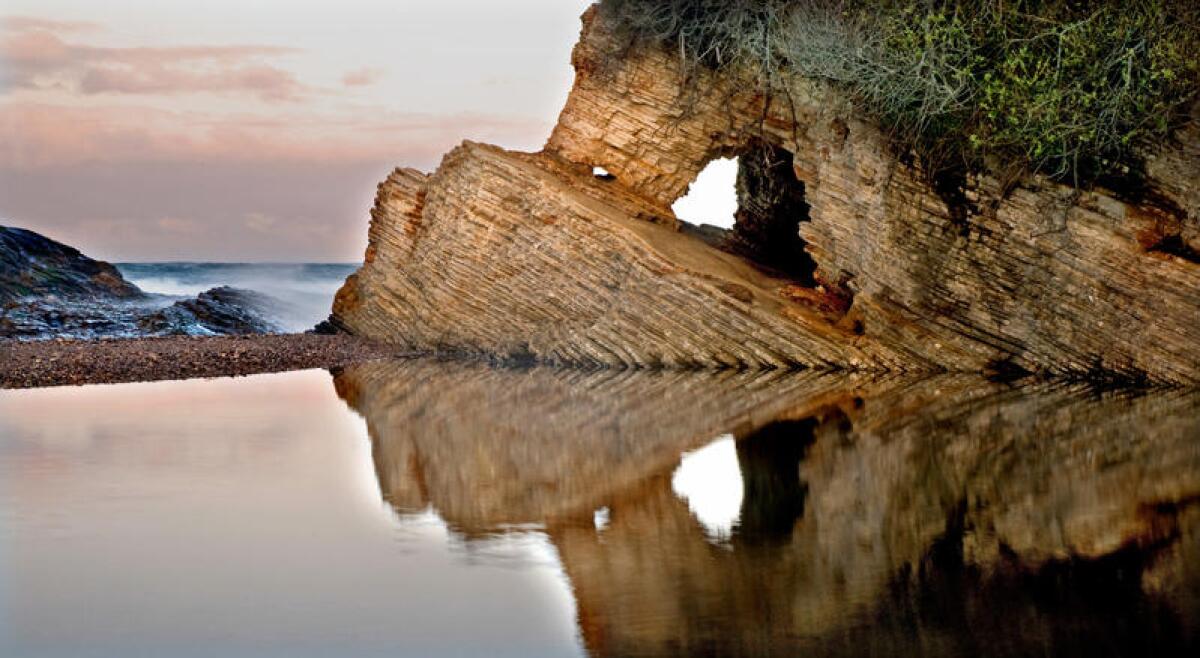
L.A. to Montaña de Oro
The route: Los Angeles to Montaña de Oro State Park, by way of U.S. 101, with optional asides on California1
Miles: 200 one way
Best time: March and April
Why: Chase sunsets much? This route is all about salty breezes and seascapes. Along the route, you can sample a Syrah in the Santa Ynez Valley, or nibble on some of America’s most-succulent barbecue in San Luis Obispo. Think of it as a pub crawl of the finest things the Golden State has to offer. When you think your trip can’t get any better, you pull into the dramatic beach campground of Montaña de Oro. Trust us. About 7 p.m., when the sun dips into the sea, heaven is envious.
Highlights: If there’s such a thing as California-Americana, historic Arroyo Grande offers it. A quicker pit stop than San Luis Obispo, or even Pismo, it offers a quaint historic district with buildings from the late 1800s. Grab lunch or an ice cream and check out the last swinging pedestrian bridge of its kind in the state. Meanwhile, the eucalyptus-lined entrance to Montaña de Oro, across from the misty 1,400-foot bluffs, is one of the finest camping gateways in the world.
Memorable stay: Campsites 18, 19, 20 at Montaña de Oro are closest to the beach; 40, 41, 42 offer a little more privacy (map).
Memorable meal: The Range, (805) 438-4500, a cowboy steakhouse eight miles north of San Luis Obispo (just off U.S. 101, exit California 58).
Tourist trap: Never much cared for the idea of pea soup on a hot summer day. But if that’s your thing, there’s the heavily publicized Pea Soup Andersen’s.
Plan to spend: A day getting there, a day or two for hiking and mental rejuvenation, a day to return.
—Chris Erskine
Gorgeous views, a headless chicken fest and Denver beckon along scenic I-70 in Utah, Colorado
L.A. to Denver
The route: Los Angeles to Denver by way of Interstate 10 to Interstate 15 to Interstate 70.
Miles: 1,016, one way
Best time: Late spring and fall. Avoid snow that may close mountain passes.
Why: I-70 through eastern Utah and western Colorado offers a phenomenally scenic journey through fascinating landscapes of sawtoothed ridges, amazing rock formations and deep canyons. It also features an area called Book Cliffs, a mountain range whose sandstone buttes appear similar to a shelf of books. Top it off with a Rocky Mountain high as you roll through Glenwood Springs on your way to Denver.
Highlights: Only a few highways in the interstate system have been named National Scenic Byways, and I-70 is one of them. You’ll want to stop at almost every scenic pull-out and rest area. The highway is about 30 miles from Utah’s Arches and Canyonlands national parks and about 50 miles from Capitol Reef National Park, three standouts in the state.
Memorable stay: My traveling companion, Piper the Princess Pup, and I capped our journey with a stay at the chic and modern Art Hotel in Denver, which celebrates the city’s love of contemporary art.
Memorable meal: Green River, Utah, is a must stop for travelers, mainly because there are no services for more than 100 miles when traveling east on 1-70 after you pass through it. Try Tamarisk Restaurant for a great view of the Green River and delicious Navajo fry bread and buffalo burgers.
Tourist traps: If you have a good sense of humor, you might plan your trip to coincide with the Mike the Headless Chicken Festival, in late May, in Fruita, Colo. Mike had an accident on the way to the dinner table in the 1940s, but lived 18 months and appeared in sideshows. Events memorializing this famous Colorado chicken include the 5K Run Like a Headless Chicken Race, Pin the Head on the Chicken and the Chicken Cluck-Off.
Plan to spend: At least a couple days on the road. Or more.
— Rosemary McClure
Road trip to Bryce Canyon, Grand Canyon and Zion national parks is a treasure-trove of discoveries
The route:
Los Angeles to Las Vegas to Cedar City and Bryce Canyon National Park, Utah; North Rim of Grand Canyon National Park, Ariz.; Kanab and Zion National Park, Utah, by way of interstates 10 and 15 to Vegas and Cedar City; Utah state highways 143 and 12 to Bryce; U.S. Highway 89A and Arizona state Highway 67 to the North Rim, returning on the same route to Utah state Highway 9 and Zion.
Miles: About 1,245
Best time: Spring, summer and fall. The North Rim of the Grand Canyon is closed during winter.
Why: There’s something to please everyone on this road trip: for the college kid, the razzle-dazzle of Las Vegas; for mom, the Bard under the stars at the Utah Shakespeare Festival in Cedar City; for both, a trio of not-to-be missed national parks. The drives between the parks are relatively short, which means more time sampling their splendors and less time behind the wheel.
Highlights: Forget that over-hyped mule ride into the Grand Canyon. Seeing Bryce on horseback on a three-hour excursion led by Canyon Trail Rides is much better. You’ll be stiff and sore for days, but the white-knuckle maneuvering on steep, narrow trails takes you into the heart of Bryce Canyon and its geologic wonders. Runner-up: Communing with the ancient spirits on the North Rim’s out-of-the-way Cliff Springs Trail. The easy 1-mile stroll takes you past an ancient Anasazi granary and down a forested ravine to a small spring and a massive stone overhang.
Memorable stay: The 1930s-era Grand Canyon Lodge, which teeters on the edge of the North Rim. Snag a chair on the veranda, put up your feet and take in the scenery: The views are stunning, day and night. As for the rooms, skip the motel-type accommodations and book one of the cottages. Rustic, as national park lodging should be.
Memorable meal: The Lodge dining room, where you can indulge in the bison flank steak, followed by the Instagram-worthy Angel’s Staircase for two: an elaborate construct of Belgian waffles, vanilla ice cream, walnuts, powdered sugar and chocolate syrup (the college kid ate the whole thing). No road trip is complete without road food, and the saucer-sized chocolate chip cookies from the bakery at Jacob Lake Inn fueled our drive into and out of the North Rim.
Tourist trap: Yep, it’s Vegas and the South Premium Outlets off the 15 about 2 1/2 miles south of the Strip. You know you’re going to stop on the way home.
Plan to spend: At least a week. We stayed just one night in Zion, a mistake that didn’t give us enough time to explore the slot canyons.
- Anne Harnagel
Find adventure and awe all along Sequoia National Park’s Mineral King Road
Mineral King Road, Calif.
The route: Start in the town of Three Rivers in Tulare County, then head to Mineral King by way of Mineral King Road in Sequoia National Park; the $30 entrance fee is good for seven days here and at nearby Kings Canyon National Park.
Miles: 25, one way
Best time: Memorial Day to mid-September
Why: Once coveted by Walt Disney as the potential site for a huge ski resort, the Mineral King Valley escaped development and is now one of the most scenic areas of Sequoia National Park.
Highlights: Unless visitors hike in, the only access is by way of Mineral King Road, a true thrill ride. It’s a narrow, heart palpitation-producing odyssey of more than 300 curves past sheer drop-offs on a sometimes-paved, sometimes-not surface.
These travails, however, produce a big reward: Scenes of jagged, snow-capped peaks, deer-filled meadows and rambling rivers without crowds. For the adventurous, Mineral King’s hiking trails depart in every direction, many leading to panoramic views of Sequoia National Park’s southern section. No exertion is needed to enjoy the area, though. For a less aerobic experience, bring a blanket and a picnic lunch to plop alongside the Kaweah River at the end of the road.
Memorable stay: Campers, head to Cold Springs Campground, one of the most scenic in the Sierra. There’s nothing like the springtime gurgling of the Kaweah River for a good night’s sleep. For a bed with four legs, the Silver City Mountain Resort, offers rustic cabins or chalets that sleep eight.
Memorable meal: The best way to end a hike is to head over to the Silver City Mountain Resort’s restaurant for its slice-of-heaven pie. Even if you’re not hungry, you will be after the first bite. The restaurant offers hearty burgers and quesadillas, too, but eat the pie first.
Tourist trap: Reimer’s Candies & Gifts in Three Rivers is just moments down Highway 198 from Mineral King Road. Chocoholics won’t be able to resist the house-made confections. For me, it’s a must-stop for ice cream after a day of hiking.
Plan to spend: About 2½ hours once departing Three Rivers. Leave the Southern California lead-foot tendencies at home and enjoy the roadside wildflowers and the vistas that get better with each passing mile.
— Michael Mello